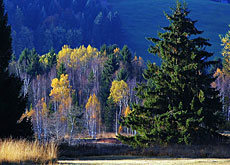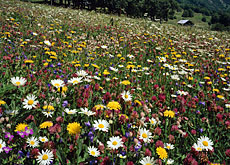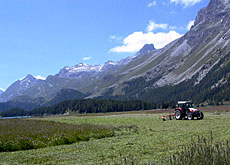Moorland protection “not good enough”

Two decades after getting a surprise thumbs up at the ballot box, an initiative to protect Switzerland’s wetlands has received a mixed review.
Environmental organisations said on Friday that while most moorland had been listed, this “protection on paper” was unsatisfactory.
The Rothenthurm Initiative was passed on December 6, 1987 – against the government’s recommendation – by 57.8 per cent of the Swiss public. Only two cantons, Valais and Schwyz, the very canton in which the commune of Rothenthurm is located, rejected it.
The initiative – which was sparked by the army’s plan to build a training ground bang in the middle of Rothenthurm’s moorland – obliged the government to conserve the “mires and mire landscapes of national importance and particular beauty”.
Around 1,700 upland moors and fens as well as 89 moorlands are currently listed and protected, according to the WWF, Pro Natura and Birdlife Switzerland, which held a news conference in Rothenthurm, central Switzerland, on Friday.
This corresponds to around 1,100 square kilometres – twice the area of Lake Constance. But while welcoming this figure, they said the total moorland in Switzerland had shrunk by five per cent since 1987.
“Despite exemplary legal protection, moors are disappearing,” said Silvia Semadeni, president of Pro Natura, one of Switzerland’s leading conservation agencies.
Semadeni said proper moorland protection was lacking and called for “urgent active revitalising measures” to protect the sites – which she said were of great ecological value – and their biodiversity.
“It’s not enough to protect them on paper,” she said, warning that many moors were gradually disappearing without people noticing because water was being diverted for agricultural purposes.
Lack of vision
Hans-Peter Fricker, head of WWF Switzerland, said that because there was no long-term national strategy on the issue, nature protection always took the form of “fire drills”.
“The government needs a vision and clear goals,” he said. “This is the only way to use efficiently the limited funds at our disposal.”
For its part, the government said it was carrying out a performance review, the results of which would be published in November.
Willy Geiger from the Federal Environment Agency admitted on Friday however that not all the moorland protection goals had been achieved, blaming this on a lack of funds and acceptance as well as the unfavourable distribution of responsibilities between cantons and communities.
But he added that without the Rothenthurm Initiative and the involvement of environmental organisations a lot more of Switzerland’s moorland would have disappeared.

More
People’s initiative
Surprise
The Swiss public’s acceptance of the Rothenthurm Initiative in 1987 went against the government’s recommendation and surprised many politicians.
Successful initiatives put forward by the Swiss public are rare. In November 2005 a proposal for a five-year ban on genetically modified organisms in Swiss agriculture became only the 15th people’s initiative – and the most recent – to be passed at the ballot box since they were introduced at the end of the 19th century.
Taking stock of Rothenthurm two decades on, Philippe Roch, head between 1992 and 2005 of what is now the Federal Environment Agency, describes the result as a “very beautiful moment”.
“It was a magnificent victory for us against the establishment,” Roch told swissinfo. “The fact that so few initiatives succeed shows how attached the Swiss are to their countryside. I think we deeply touched the country’s soul.”
swissinfo with agencies
Switzerland has a long record of federal environmental and sustainable development legislation and strategies. The Swiss public and non-governmental organisations continue to be a driving force behind policies for protected areas.
Examples include the 1971 Swiss Water Protection Act, the 1987 Rothenthurm Initiative, the 1995 CO2 strategy, the 2002 Sustainable Development Strategy and the Landscape 2020 strategy for nature and landscape.
Nevertheless the percentages of rare, endangered or extinct animal and plant species in Switzerland are among the highest in the OECD for mammals, fish, reptiles, amphibians and vascular plants, and the highest for birdlife (56%).
Federal Environment Agency: protected areas in Switzerland
87% of fens
91% of upland moors
85% of moorland

In compliance with the JTI standards
More: SWI swissinfo.ch certified by the Journalism Trust Initiative










You can find an overview of ongoing debates with our journalists here . Please join us!
If you want to start a conversation about a topic raised in this article or want to report factual errors, email us at english@swissinfo.ch.